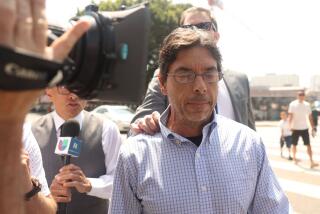Doctor arrested in alleged illegal drug prescriptions
A Southern California pain doctor who was featured in a 2012 Times investigative article on patient overdose deaths was arrested Tuesday on seven counts of illegally prescribing narcotics and other widely abused drugs.
Dr. John Dimowo is charged with prescribing Vicodin, Norco, Adderall and Xanax to undercover agents who pretended to be patients but had no legitimate need for the drugs.
Dimowo was not charged in connection with any patient deaths. The Times reported in November that five of Dimowo’s patients fatally overdosed on medications he prescribed between 2009 and 2010, coroner’s records show. They ranged in age from 26 to 59.
Los Angeles Deputy Dist. Atty. John Niedermann said he hoped the case sends a message to physicians. “Doctors are gatekeepers and they are entrusted with improving the health of the public,” he said. “But when we find doctors who are doing the opposite — and actually bringing harm to their patients — we are going to hold them responsible.”
Dimowo, 55, faces up to seven years in prison if convicted of the charges stemming from the agents’ visits to his Wilmington office in March and May 2012, Niedermann said.
Steve Meister, Dimowo’s attorney, said Tuesday that he was being denied access to the doctor, who was being held at the San Dimas sheriff’s station, so he had yet to speak with him.
But Meister said he was confident Dimowo would emerge from “this so-called case unscathed, as he deserves to.”
Meister declined to comment further.
The investigation into the doctor was prompted by complaints to the Medical Board of California, according to an affidavit filed in support of a search warrant. Family members of patients, pharmacists and others told the medical board that they believed Dimowo’s prescriptions were fueling his patients’ addictions, the affidavit said.
Dimowo was a prolific prescriber of painkillers, such as Vicodin, writing an average of at least 37 prescriptions a day, according to the affidavit. And undercover agents posing as patients were able to get prescriptions for addictive drugs without the doctor examining them, it said.
After the Times report, the medical board obtained a list of dead patients from the Orange County coroner’s office, the affidavit said. Authorities searched Dimowo’s office looking for medical records of patients who “possibly died of overdosing on prescription medication.”
Authorities investigated Dimowo in connection with the deaths highlighted in The Times, but did not find sufficient evidence to hold him criminally liable, Niedermann said.
Charging a doctor in connection with a death is complicated by various factors, he said, including patients obtaining drugs from multiple physicians, mixing prescription drugs with street drugs, and having preexisting medical conditions that contribute to their demise.
“The evidence didn’t leave a direct path,” he said.
Dimowo, a native of Nigeria, was trained in anesthesiology and pain management in the United States. He is board-certified in both specialties. In 2007, after serving as a chief of anesthesia at Anaheim Regional Medical Center, he opened his pain management practice because he wanted to spend time with patients and help ease their suffering, Dimowo said in an interview with The Times last year.
It can be difficult, he said, to tell whether someone truly needs narcotic painkillers or is simply looking to get high.
“Pain is a difficult thing to define,” he said in the interview. “You can’t say, ‘No. You don’t have pain.... You’re just seeking drugs.’ It’s very difficult to tell anybody that.”
But if he believes a patient is abusing drugs, he said, “they are out of my clinic. I would send them to a psychiatrist, because that’s where they belong.”
Informed of the fatal overdoses identified by The Times, he said the patients and their family members shared responsibility.
“We all need to be vigilant,” he said.
More to Read
Sign up for Essential California
The most important California stories and recommendations in your inbox every morning.
You may occasionally receive promotional content from the Los Angeles Times.












